Combination of Tree Rings and Other Paleoclimate Proxies to Explore the East Asian Summer Monsoon and Solar Irradiance Signals: A Case Study on the North China Plain
Abstract
:1. Introduction
2. Data and Methods
2.1. Climatological Data of the Study Area
2.2. Principal Component Analysis
2.3. Multiple Paleoclimate Proxies and Their Principal Component Analysis
3. Results and Discussion
3.1. Spatial Representation of the Principal Component Analysis Series
3.2. Variation in the East Asian Summer Monsoon Reflected by the Principal Component Analysis Series
3.3. Relationship between the Principal Component Analysis Series and the El Nino–Southern Oscillation
3.4. Relationship between the Principal Component Analysis Series and Solar Activity
4. Conclusions
Author Contributions
Funding
Conflicts of Interest
References
- Jin, L. Principles of Urban. Disaster Science; China Meteorological Press: Beijing, China, 1997. [Google Scholar]
- Li, S.Y.; Ma, J.J.; Xuan, C.Y.; Wang, J. Analysis of extreme weather events in Beijing during 1951–2008. Clim. Environ. Res. 2012, 17, 244–250. [Google Scholar]
- Liu, Y.; Xiang, N.; Song, H.M. Tree-ring records in Arxan, Inner Mongolia for the past 187 years. J. Earth Environ. 2012, 3, 862–867. [Google Scholar]
- Lei, Y.; Liu, Y.; Song, H.; Sun, B. A wetness index derived from tree-rings in the Mt. Yishan area of China since 1755 AD and its agricultural implications. Chin. Sci. Bull. 2014, 59, 3449–3456. [Google Scholar] [CrossRef]
- Wang, Q.; Zhou, H.Y.; Cheng, K.; Chi, H.; Wang, H.; Wang, C.; Ma, Q. Stalagmite records of climatic and environmental changes on western Shandong peninsula in the past 1000 years: Lamina thickness. Mar. Geol. Quat. Geo. 2015, 6, 133–138. [Google Scholar]
- Xu, Y.B. Compound Specific Carbon and Hydrogen Isotopes of Long Chain N-Alkane Extracted from Past 15 ka Lacustrine Sediments of Gonghai Lake, Shanxi Province, and Their Paleoclimatic Significance. Dissertation (Master’s Thesis), Lanzhou University, Lanzhou, China, 2014. [Google Scholar]
- Chi, H.; Zhang, Z.H.; Zhao, Q. Paleoclimate and paleoenvironmental records of the Karst in the past 1000 years. J. Ludong Univ. 2016, 32, 278–283. [Google Scholar]
- Wu, X.D.; Shao, X.M. Status of dendroclimatological study and its prospects in China. Adv. Earth Sci. 1993, 1, 31–35. [Google Scholar]
- Cook, E.R.; Anchukaitis, K.J.; Buckley, B.M.; D’Arrigo, R.D.; Jacoby, G.C.; Wright, W.E. Asian Monsoon Failure and Megadrought During the Last Millennium. Science 2010, 328, 486–489. [Google Scholar] [CrossRef] [Green Version]
- Büntgen, U.; Tegel, W.; Nicolussi, K.; McCormick, M.; Frank, D.; Trouet, V.; Kaplan, J.O.; Herzig, F.; Heussner, K.-U.; Wanner, H.; et al. 2500 Years of European Climate Variability and Human Susceptibility. Science 2011, 331, 578–582. [Google Scholar] [CrossRef] [Green Version]
- Liu, Y.; Xie, L.; Li, Q.; Cai, Q. Growth-climate response analysis between tree-ring width and March-September mean minimum temperature in Dongda Mountain, Gansu, China since 1820 AD. J. Earth Environ. 2012, 3, 900–907. [Google Scholar]
- Zhang, Y.C.; Wu, K.; Yu, J.J.; Xia, J. Characteristics of precipitation and air temperature variation during 1951-2009 in North China. J. Nat. Res. 2011, 26, 1930–1941. [Google Scholar]
- Ma, X.B. Climate characteristics of water resources in North China. Plat. Meteo. 1999, 18, 520–524. [Google Scholar]
- Duo, A.; Zhao, W.J.; Gong, Z.N.; Zhang, M.; Fan, Y.B. Temporal analysis of climate change and its relationship with vegetation cover on the north china plain from 1981 to 2013. Acta Ecol. Sin. 2017, 37, 576–592. [Google Scholar] [CrossRef]
- Xu, R.T.; Wu, Y. Water resources in north China face difficulties and solutions. Edu. Geo. 2014, 18, 57–58. [Google Scholar]
- Hu, S.Q.; Cao, Z.C.; Liu, T.T. Change features of extreme drought events in North China. Meteo. Environ. Sci. 2017, 24, 121–125. [Google Scholar]
- Fu, Y.; Tao, F.; Hao, H.Y.; Cao, Y.; Chen, H.J.; Lin, H.T. Establishment of quality evaluation index system for dehydrated litchi. J. Chin. Inst. Food Sci. Technol. 2013, 13, 158–164. [Google Scholar]
- Kong, H.Y.; An, G.A.; Shi, S.J.; Zhang, L.Z.; Xing, Y. Comprehensive evaluation of water environmental quality based on PCA analysis. Pollut. Control. Technol. 2019, 32, 6–8. [Google Scholar]
- Ni, Y.N. The Application of Stoichiometry in Analytical Chemistry; Science Press: Beijing, China, 2004; pp. 161–169. [Google Scholar]
- Liu, Y.; Lei, Y.; Song, H.M.; Bao, J.; Sun, B.; Linderhoim, H.W. The annual mean lowest temperature reconstruction based on Pinus bungeanas (Pinus bungeana Zucc) ring width in the Yulin region, Shandong, China since AD 1616. J. Earth Environ. 2010, 1, 28–35. [Google Scholar]
- Li, Q.; Nakatsuka, T.; Kawamura, K.; Liu, Y.; Song, H. Hydroclimate variability in the North China Plain and its link with El Niño-Southern Oscillation since 1784 A.D.: Insights from tree-ring celluloseδ18O. J. Geophys. Res. Space Phys. 2011, 116, 116. [Google Scholar] [CrossRef] [Green Version]
- Tan, M.; Liu, T.; Hou, J.; Qin, X.; Zhang, H.; Li, T. Cyclic rapid warming on centennial-scale revealed by a 2650-year stalagmite record of warm season temperature. Geophys. Res. Lett. 2003, 30, 30. [Google Scholar] [CrossRef]
- Shen, C.; Wang, W.-C.; Hao, Z.; Gong, W. Characteristics of anomalous precipitation events over eastern China during the past five centuries. Clim. Dyn. 2007, 31, 463–476. [Google Scholar] [CrossRef]
- Bretherton, C.S.; Widmann, M.; Dymnikov, V.P. The effective number of spatial degrees of freedom of a time-varying field. J. Clim. 1999, 12, 1990–2009. [Google Scholar] [CrossRef]
- KNMI Explorer. Available online: http://climexp.knmi.nl (accessed on 16 August 2019).
- Liu, Y.; Cai, W.; Sun, C.; Song, H.; Cobb, K.M.; Li, J.; Leavitt, S.W.; Wu, L.; Cai, Q.; Liu, R.; et al. Anthropogenic Aerosols Cause Recent Pronounced Weakening of Asian Summer Monsoon Relative to Last Four Centuries. Geophys. Res. Lett. 2019, 46, 5469–5479. [Google Scholar] [CrossRef] [Green Version]
- Sun, C.; Liu, Y.; Cai, Q.; Li, Q.; Song, H.; Fang, C.; Liu, R. Similarities and differences in driving factors of precipitation changes on the western Loess Plateau and the northeastern Tibetan Plateau at different timescales. Clim. Dyn. 2020, 55, 1–14. [Google Scholar] [CrossRef]
- Man, W.; Zhou, T.; Jungclaus, J.H. Effects of Large Volcanic Eruptions on Global Summer Climate and East Asian Monsoon Changes during the Last Millennium: Analysis of MPI-ESM Simulations. J. Clim. 2014, 27, 7394–7409. [Google Scholar] [CrossRef]
- Zhuo, Z.; Gao, C.; Pan, Y. Proxy evidence for China’s monsoon precipitation response to volcanic aerosols over the past seven centuries. J.Geophys. Res. Atmos. 2014, 119, 6638–6652. [Google Scholar] [CrossRef]
- Huang, R.H.; Gu, L.; Chen, J.L.; Huang, G. Recent progresses in studies of the temporal-spatial variations of the east monsoon system and their impacts on climate anomalies in China. Chin. J. Atmos. Sci. 2008, 32, 691–719. [Google Scholar]
- Wang, Y.; Wang, B.; Oh, J.-H. Impact of the Preceding El Nino on the East Asian Summer Atmosphere Circulation. J. Meteorol. Soc. Jpn. 2001, 79, 575–588. [Google Scholar] [CrossRef] [Green Version]
- Guo, Q.Y. The summer monsoon intensity index in East Asia and its variation. Acta. Geo. Sin. 1983, 50, 207–217. [Google Scholar]
- Lau, K.-M.; Kim, K.-M.; Yang, S. Dynamical and Boundary Forcing Characteristics of Regional Components of the Asian Summer Monsoon. J. Clim. 2000, 13, 2461–2482. [Google Scholar] [CrossRef]
- Zhang, J.; Yang, J.L.; Gao, F. Relationship between ENSO events and precipitation in Zhaoyuan city from 1981 to 2010. Meteo. J. Inner Mongolia. 2017, 24, 17–21. [Google Scholar]
- Li, H.; Zhou, S.W.; Wang, Y.F. A review on relationship between subtropical high anomaly over West Pacific and summer precipitation in the middle-lower reaches of the Yangtze River. J. Meteo. Environ. 2013, 29, 93–102. [Google Scholar]
- Pascolini-Campbell, M.; Zanchettin, D.; Bothe, O.; Timmreck, C.; Matei, D.; Jungclaus, J.H.; Graf, H.-F. Toward a record of Central Pacific El Niño events since 1880. Theor. Appl. Clim. 2014, 119, 379–389. [Google Scholar] [CrossRef]
- Liu, Y.; Cobb, K.M.; Song, H.; Li, Q.; Li, C.Y.; Nakatsuka, T.; An, Z.; Zhou, W.; Cai, Q.; Li, J.; et al. Recent enhancement of central Pacific El Niño variability relative to last eight centuries. Nat. Commun. 2017, 8, 15386. [Google Scholar] [CrossRef] [Green Version]
- Li, Q.; Liu, Y.; Nakatsuka, T.; Zhang, Q.B.; Ohnishi, K.; Sakai, A.; Kobayashi, O.; Pan, Y.; Song, H.; Liu, R.; et al. Oxygen stable isotopes of a network of shrubs and trees as high-resolution plaeoclimatic proxies in Northwestern China. Agric. For. Meteorol. 2020, 107929. [Google Scholar] [CrossRef]
- Lockwood, M.; Rouillard, A.P.; Finch, I.D. The rise and fall of open solar flux during the current grand solar maximum. Astrophys. J. 2009, 700, 937–944. [Google Scholar] [CrossRef]
- Mann, M.E.; Cane, M.A.; Zebiak, S.E.; Clement, A. Volcanic and Solar Forcing of the Tropical Pacific over the Past 1000 Years. J. Clim. 2005, 18, 447–456. [Google Scholar] [CrossRef] [Green Version]
- Xiao, Z.N.; Zhong, Q.; Yin, Z.Q.; Zhou, L.; Song, Y.; Han, Y. Advances in the research of impact of decadal solar cycle on modern climate. Adv. Earth Sci. 2013, 28, 1335–1348. [Google Scholar]
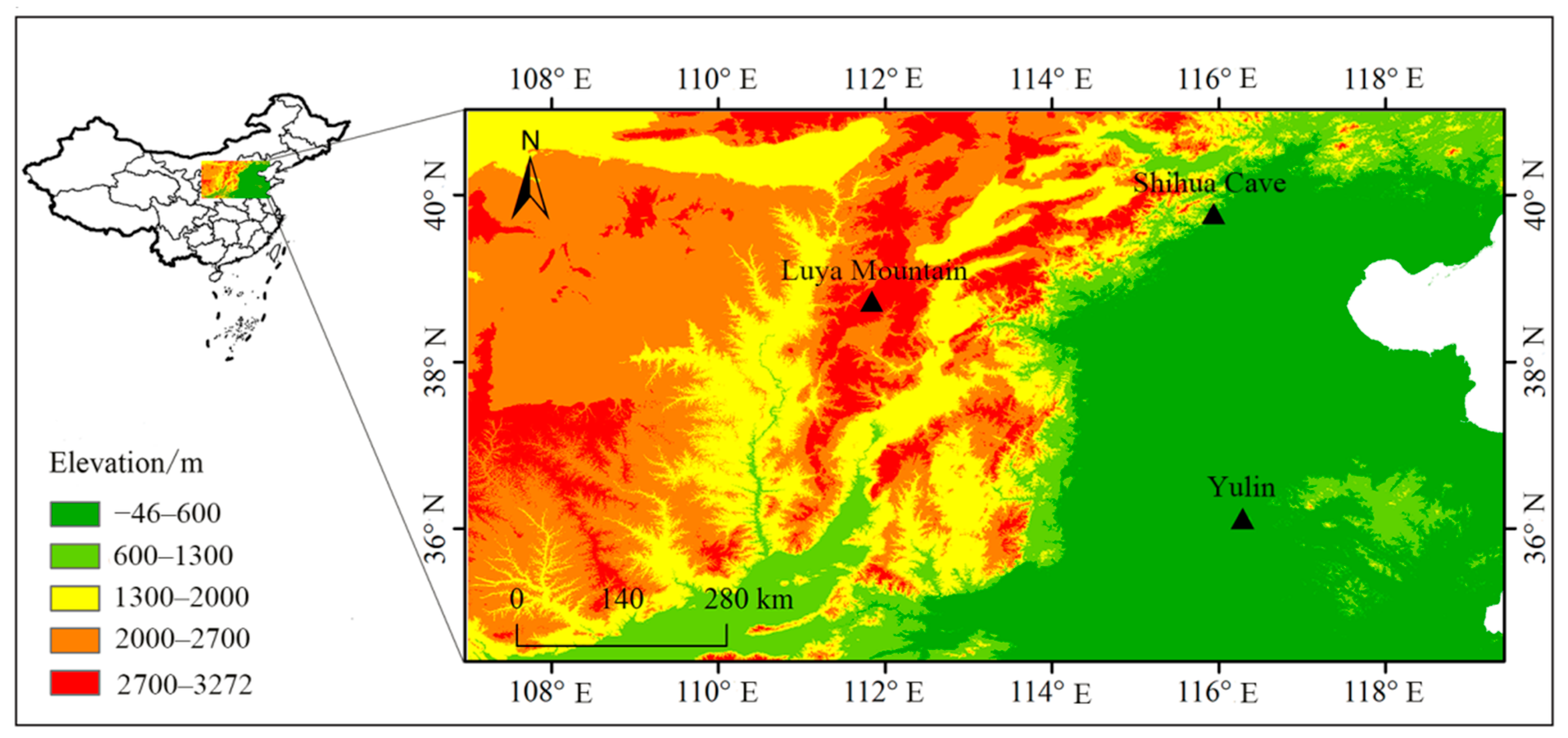
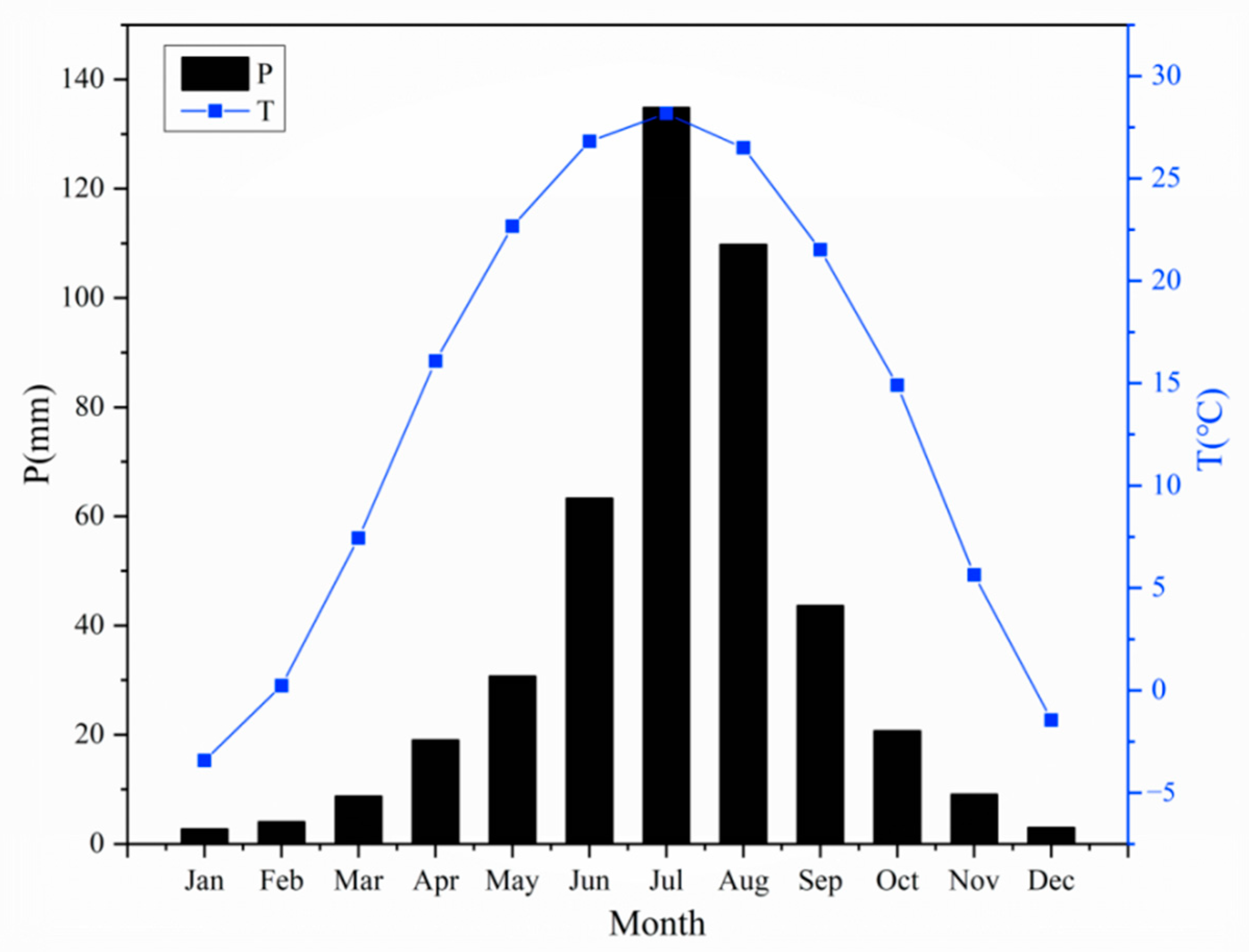
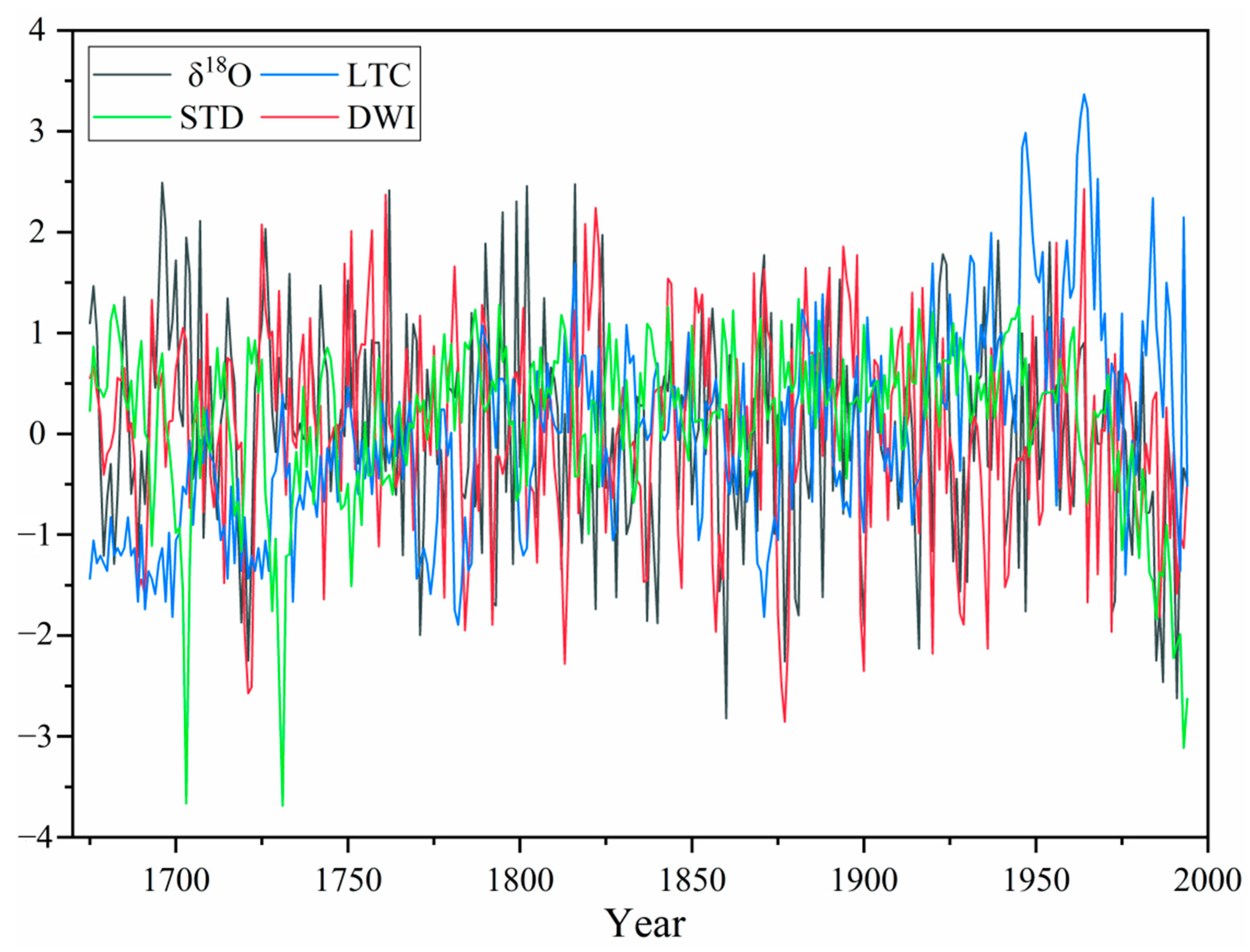

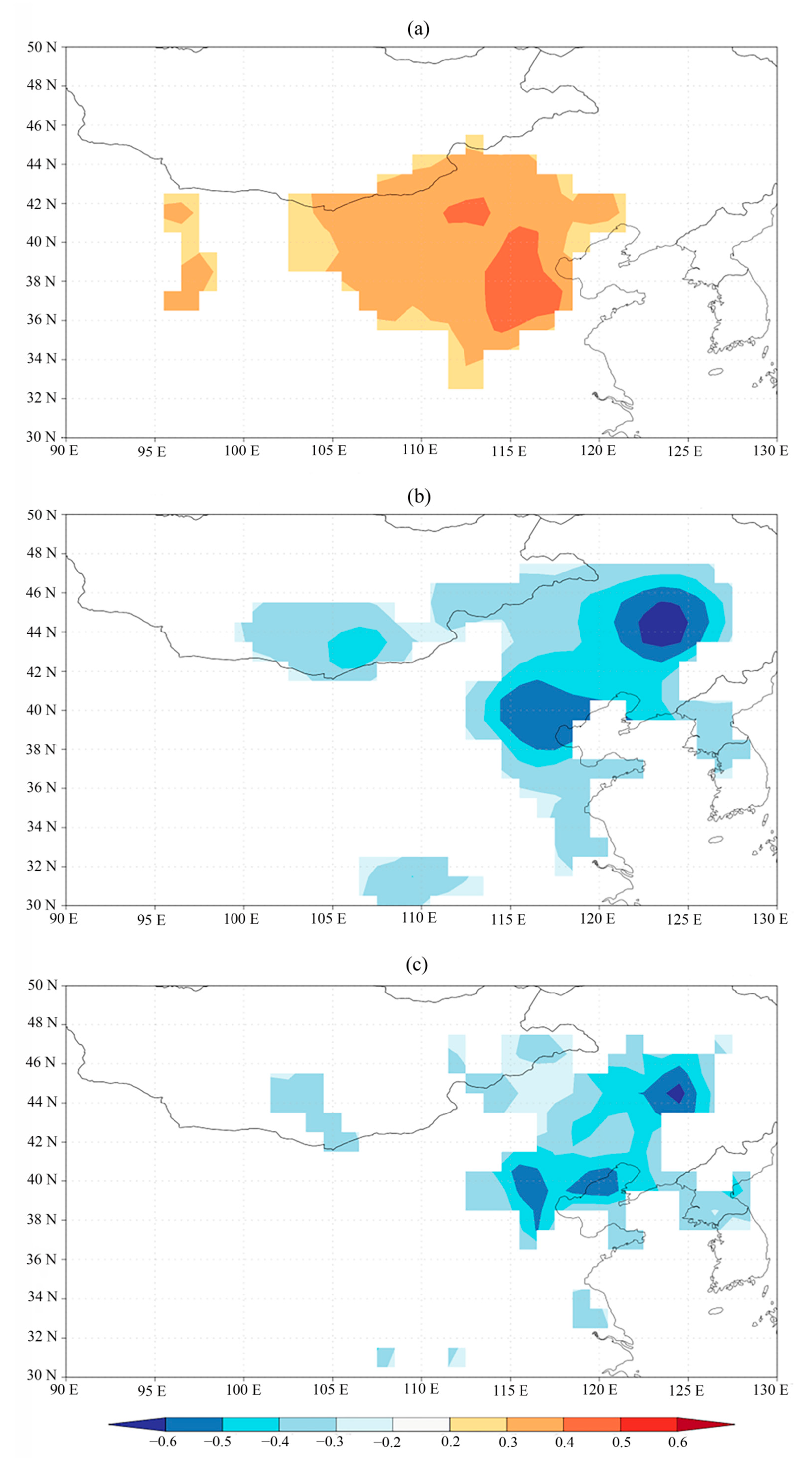
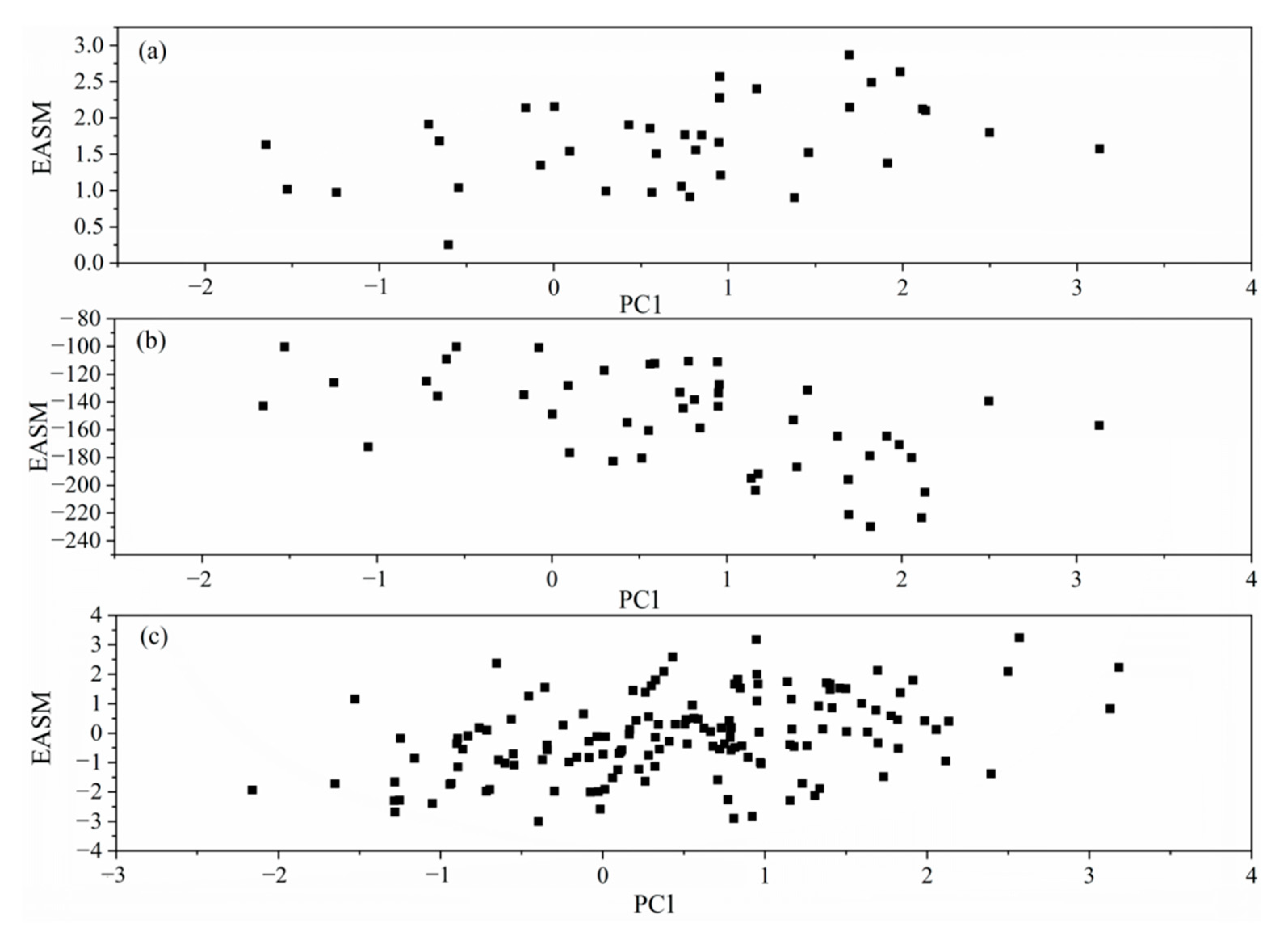
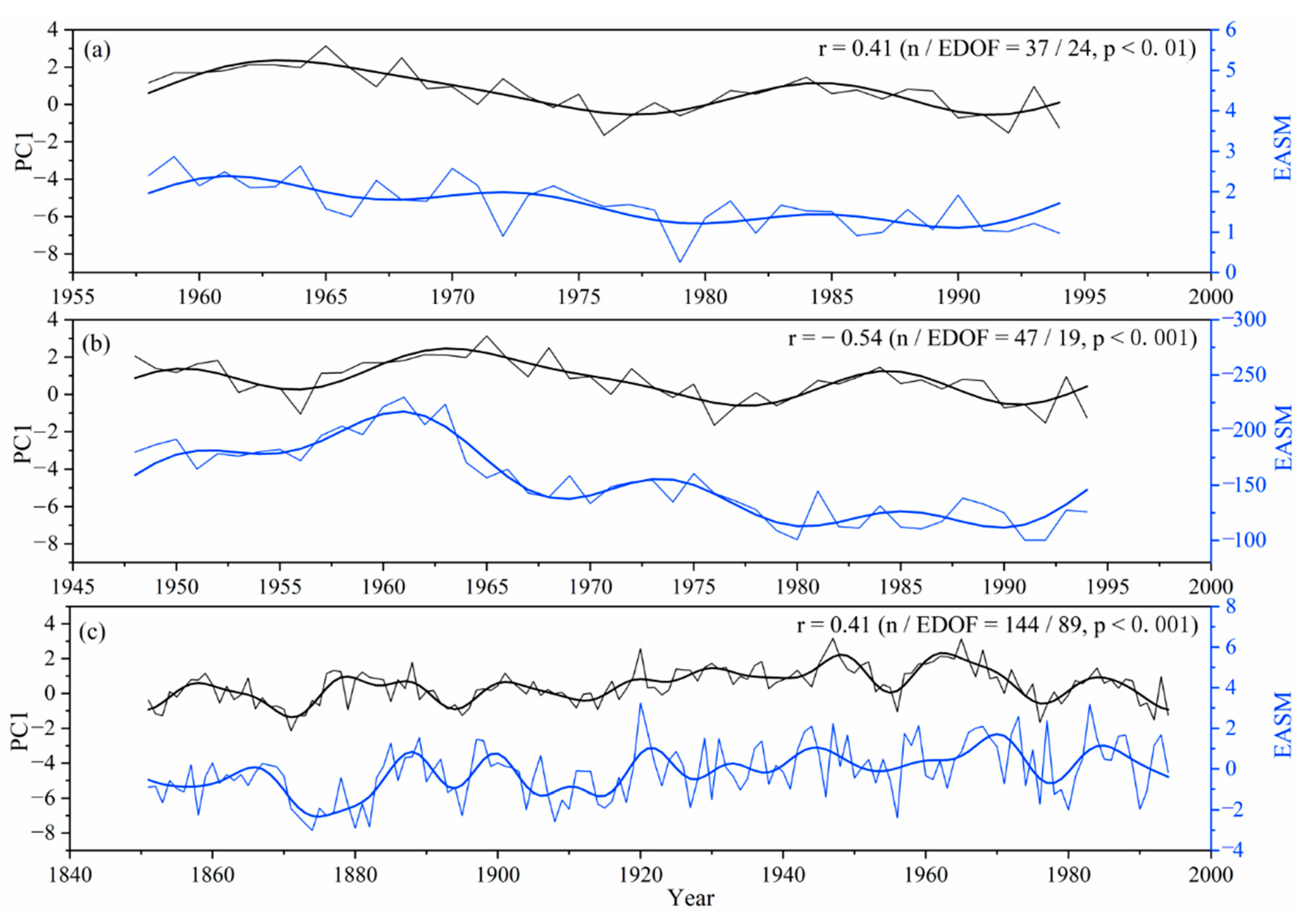
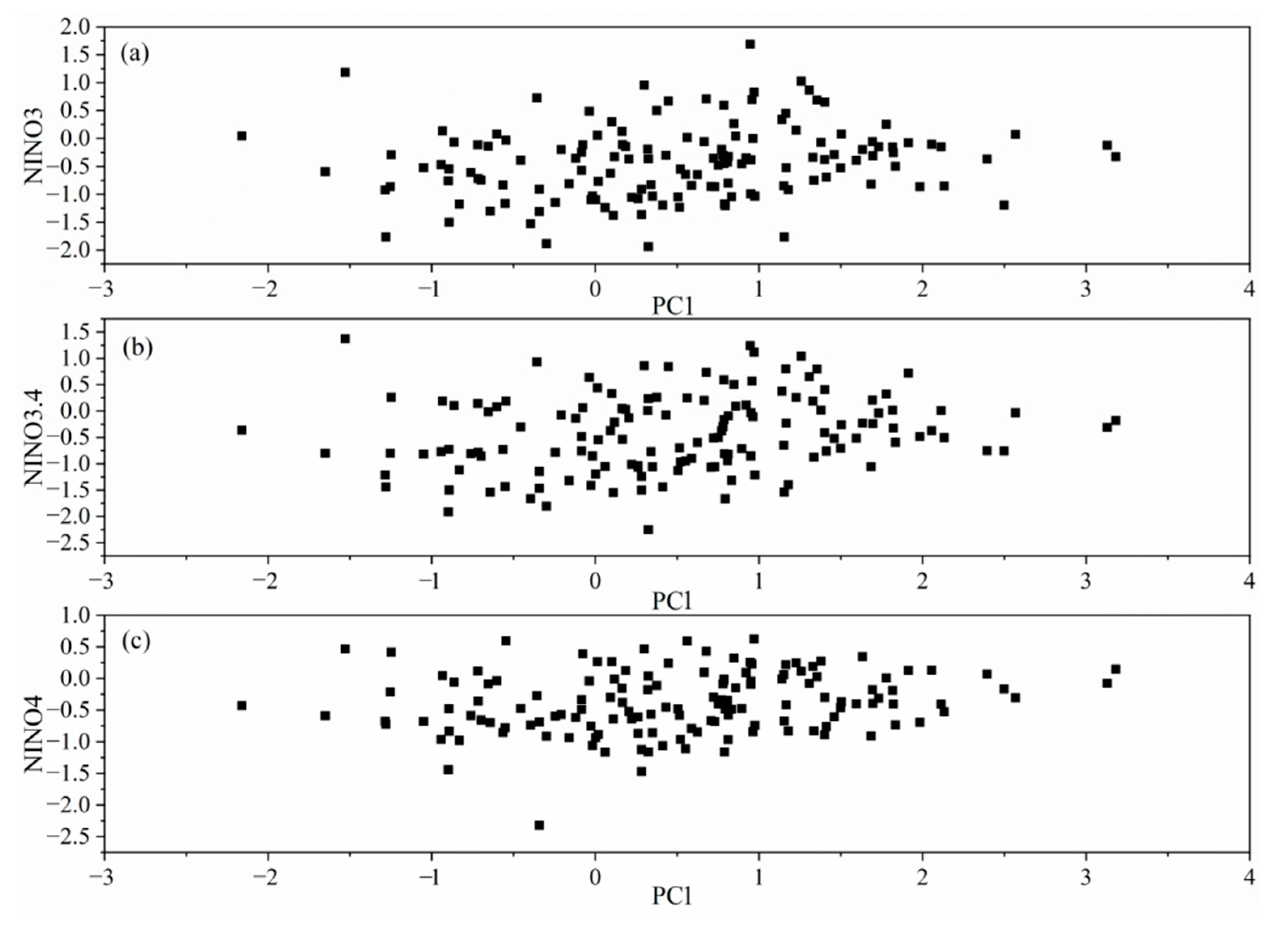


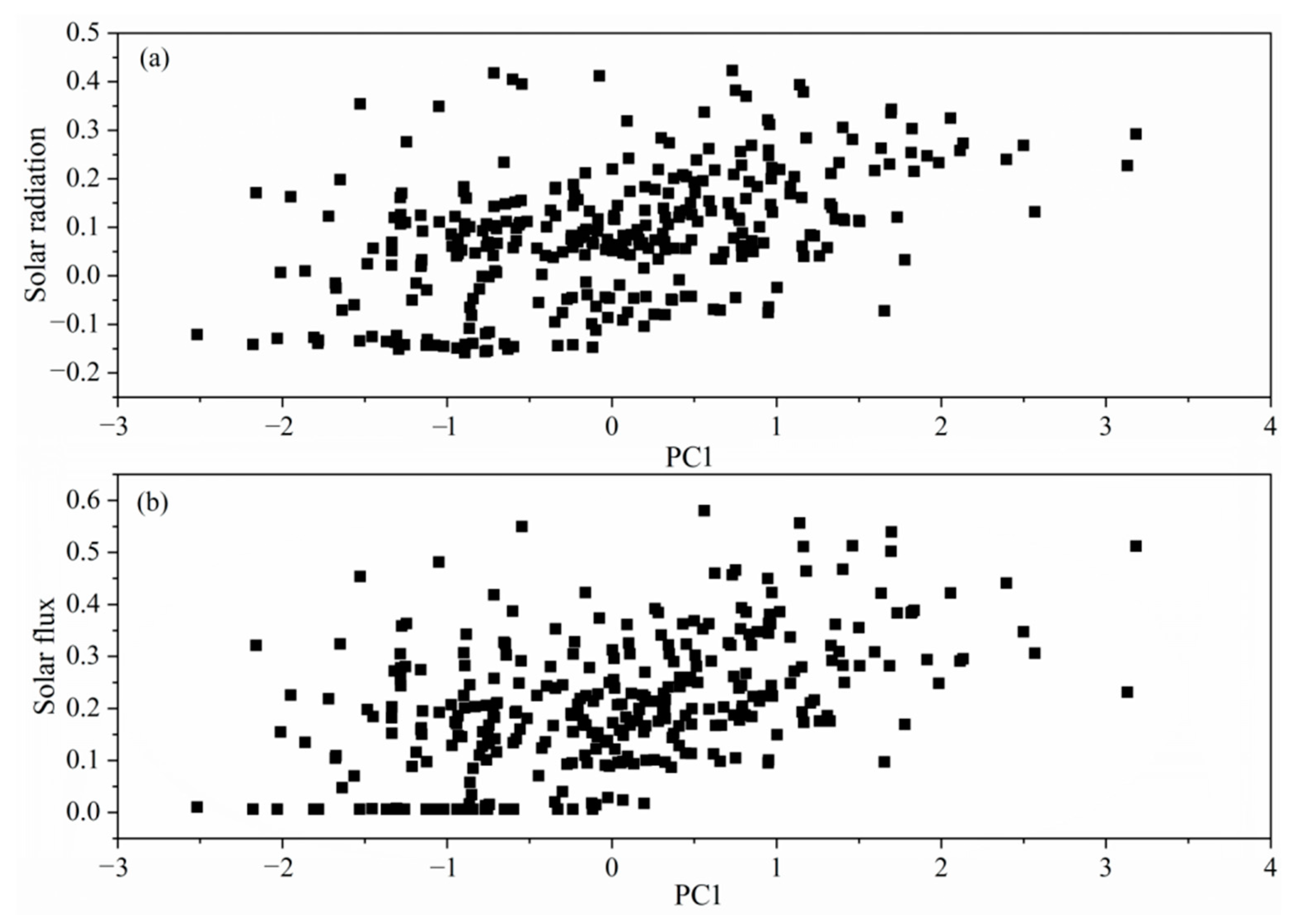
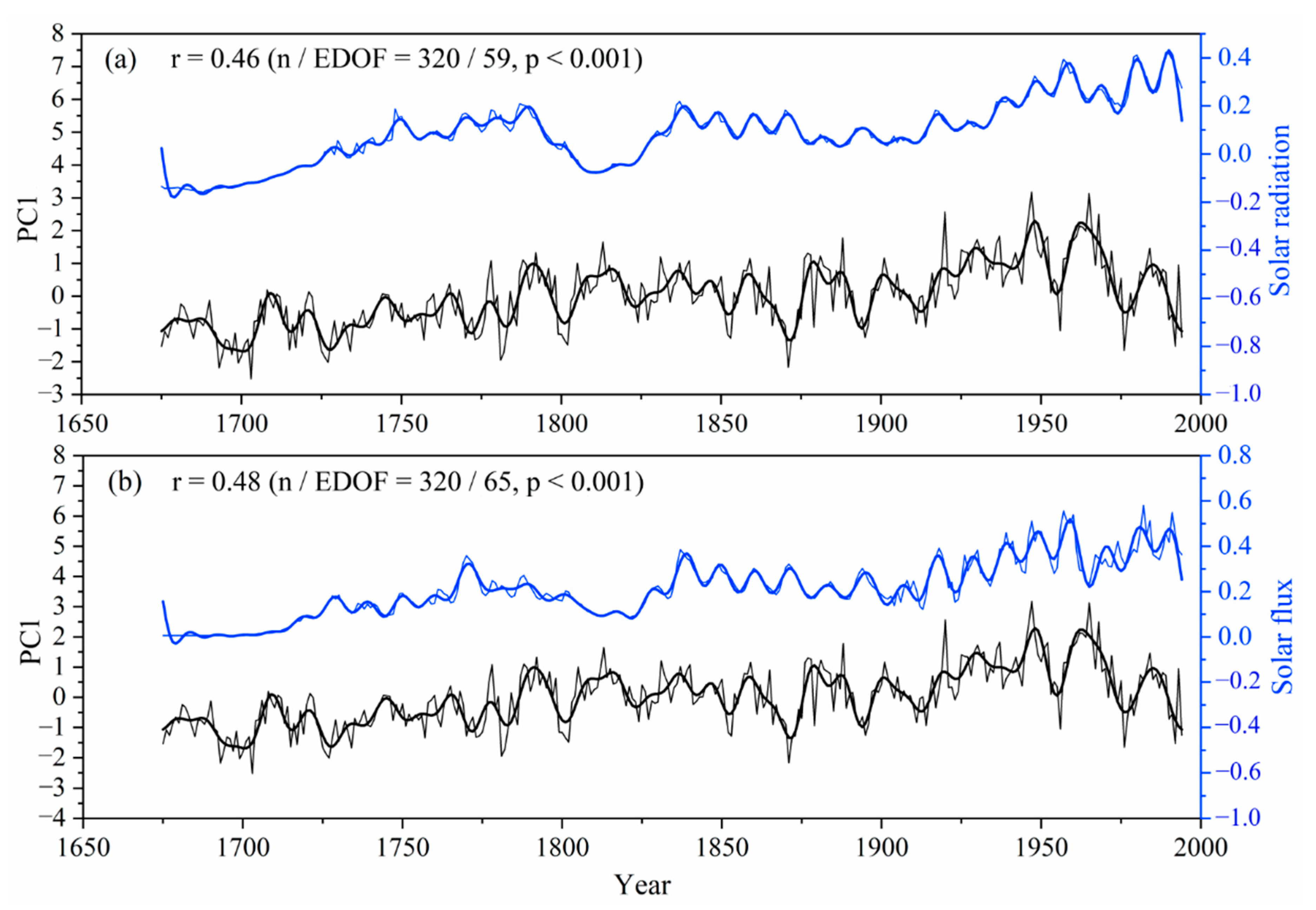
Publisher’s Note: MDPI stays neutral with regard to jurisdictional claims in published maps and institutional affiliations. |
© 2020 by the authors. Licensee MDPI, Basel, Switzerland. This article is an open access article distributed under the terms and conditions of the Creative Commons Attribution (CC BY) license (http://creativecommons.org/licenses/by/4.0/).
Share and Cite
Li, Q.; Liu, Y.; Deng, R.; Liu, R.; Song, H.; Wang, Y.; Li, G. Combination of Tree Rings and Other Paleoclimate Proxies to Explore the East Asian Summer Monsoon and Solar Irradiance Signals: A Case Study on the North China Plain. Atmosphere 2020, 11, 1180. https://doi.org/10.3390/atmos11111180
Li Q, Liu Y, Deng R, Liu R, Song H, Wang Y, Li G. Combination of Tree Rings and Other Paleoclimate Proxies to Explore the East Asian Summer Monsoon and Solar Irradiance Signals: A Case Study on the North China Plain. Atmosphere. 2020; 11(11):1180. https://doi.org/10.3390/atmos11111180
Chicago/Turabian StyleLi, Qiang, Yu Liu, Ruolan Deng, Ruoshi Liu, Huiming Song, Yan Wang, and Gang Li. 2020. "Combination of Tree Rings and Other Paleoclimate Proxies to Explore the East Asian Summer Monsoon and Solar Irradiance Signals: A Case Study on the North China Plain" Atmosphere 11, no. 11: 1180. https://doi.org/10.3390/atmos11111180
APA StyleLi, Q., Liu, Y., Deng, R., Liu, R., Song, H., Wang, Y., & Li, G. (2020). Combination of Tree Rings and Other Paleoclimate Proxies to Explore the East Asian Summer Monsoon and Solar Irradiance Signals: A Case Study on the North China Plain. Atmosphere, 11(11), 1180. https://doi.org/10.3390/atmos11111180






